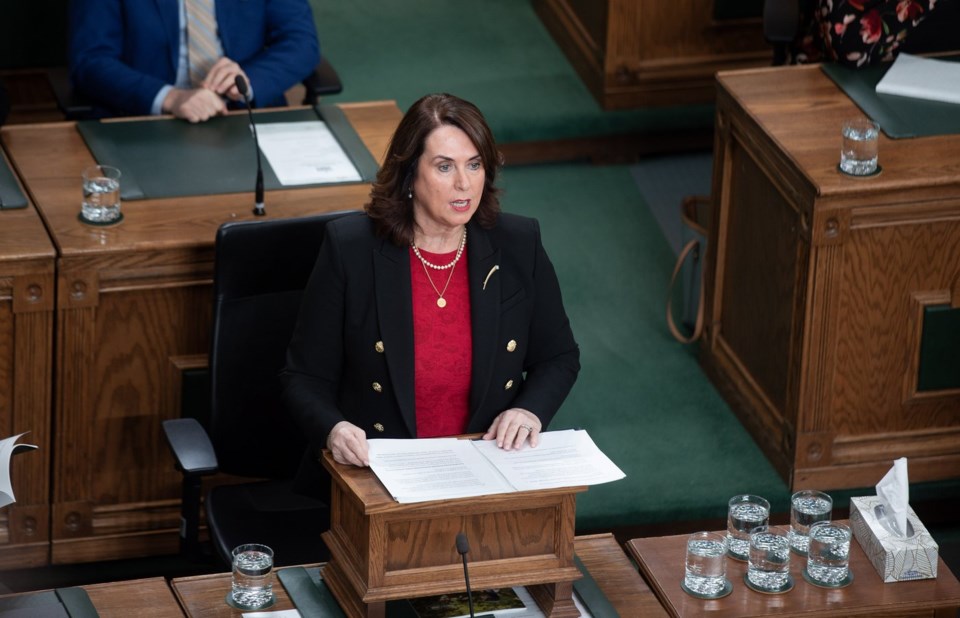ST. JOHN'S — The Newfoundland and Labrador government is delaying its plan to balance the books for another year, with a new budget forecasting a $372-million deficit as the province navigates uncertainty from decisions made south of the border.
With U.S. President Donald Trump threatening and, in some cases, implementing tariffs on Canadian goods, Finance Minister Siobhan Coady said Wednesday it was not the right time for the province to tighten its fist on spending.
“We’re in a period of global instability. There are a lot of uncertainties,” Coady told reporters. “Now is not the time to make the dramatic changes to ensure that we’re back to balance.”
The deficit in Coady’s $11-billion budget for the 2025-26 fiscal year is $120 million higher than last year. The province will borrow $4.1 billion to pay its bills, and its net debt will hit $19.4 billion. Ten per cent of spending is dedicated to paying down debt.
Coady defended the deficit and the borrowing, noting that the forecasted shortfall represents about three per cent of revenues for the year. Some of the billions of dollars in borrowing will pay for infrastructure, including a new mental health hospital opening next week in the capital of St. John’s, the Liberal minister said.
The province is setting aside a $200-million contingency fund to offset any fallout from U.S. tariffs, which Trump has imposed on a number of Canadian goods, including steel, aluminum and autos, and threatened on others. The reserve fund is not part of the forecasted deficit; the government could fall further into the red if any of that money is used, officials said.
The largest line item in Coady’s budget was $4.4 billion for health care, which accounts for about 40 per cent of total spending.
Newfoundland and Labrador is home to about 545,000 people, many of whom live in small communities spread out across a vast area. It has long struggled to recruit and retain doctors and nurses and provide health-care to its population.
Coady’s budget, titled “Smarter. Stronger. Better,” promises an end to deficits by the next fiscal year as long as revenues increase and spending decreases slightly.
Balancing the budget has been a moving target for Coady. In 2021, her department had aimed to be out of the red by the 2026-27 fiscal year. In 2023, she revised that goal, saying the books would be balanced in the fiscal year that ended on March 31.
The budget forecasts that real GDP growth, adjusted for inflation, will be 4.4 per cent in 2025 and fall to 1.6 per cent in 2026. The province's GDP grew by 6.7 per cent in 2024.
The province expects GDP to rise to 3.5 per cent in 2027, driven by expected income from energy projects that haven’t yet been built. Those include Equinor’s Bay du Nord offshore oil development, for which the company has not yet made an investment decision, officials said. Income from a sweeping new energy deal that would see Quebec pay much more for power from Labrador is also included, beginning with more than $700 million in the next fiscal year.
Royalties from the four oilfields off the coast of St. John's will account for about 15 per cent of the province’s income this fiscal year, the budget said.
It also allocates $90 million over three years to support more oil exploration.
Energy Minister Andrew Parsons said the leaders of the federal Liberal and Conservative parties seem to support an end to what he described as a “chilling effect” on oil and gas development.
“I’m excited by the conversations going on,” he told reporters.
Parsons has been part of an effort to foster a green hydrogen industry, and there are five wind-powered hydrogen projects in various stages of the government approval process. One, in western Newfoundland, has already cleared its environmental assessments.
The sector has faced delays, Parsons acknowledged, but he suggested one company has found a buyer for its hydrogen.
Opposition Leader Tony Wakeham said he would have liked for the budget to include details on how the government will recruit health workers. Roughly 30 per cent of the population does not have a family doctor and the provincial health authority is trying to wean itself off costly private agency nurses.
"I'm not seeing concrete measures in the budget to address that," the Progressive Conservative party leader said in an interview. "If you have no plan and are simply reacting, then you actually wind up spending a lot more money."
Jim Dinn, leader of the NDP, said the budget didn't do enough to help those struggling with the cost of living. "It misses the reality of many people in this province," Dinn told reporters.
Newfoundland and Labrador had the highest rate of food insecurity among the provinces in 2022, according to University of Toronto research group Proof.
Wednesday’s budget is the last under outgoing Liberal Premier Andrew Furey. He came to power in 2020 and won an election the following year, vowing to pull the province out of debt and right its financial course. His government has managed to shrink the deficit from roughly $1.6 billion in the 2020-21 fiscal year. The net debt, however, has shown stubborn growth.
Nonetheless, Coady pointed to a series of economic milestones the province hit recently, including the highest GDP in the province's history, as well as record employment and household income rates.
“I think we’re in good shape,” she said.
This report by The Canadian Press was first published April 9, 2025.
Sarah Smellie, The Canadian Press



